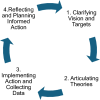Coproducing justice in public involvement: impact-led iterative development of a dance based community engagement project building relationships in marginalised communities
- PMID: 40340780
- PMCID: PMC12060390
- DOI: 10.1186/s40900-025-00714-2
Coproducing justice in public involvement: impact-led iterative development of a dance based community engagement project building relationships in marginalised communities
Abstract
Background: Public involvement must include people from diverse backgrounds, or it risks exacerbating health inequalities in prioritising the needs of the majority culture. Public involvement as a process tends to exclude people by being tailored to fit the norms of the dominant culture; therefore simply removing barriers to participation is unlikely to be effective as is the case in other areas of science engagement. Rather it is necessary to go beyond redistributive justice (fair distribution of resources, opportunities, and benefits within health research) towards relational justice (developing respectful, reciprocal relationships and fair treatment within the research process and seeking to develop models of involvement that are meaningful and appealing to all groups).
Methods: An action research approach was applied to the iterative development of an arts based participatory community engagement project to engage South Asians in Leicester, particularly women from inter-sectionally deprived neighbourhoods. Seven action research cycles were completed between 2017 and 2024, of which the first five are reported here. Data collection and analysis are summarised in Supplementary Table 01 and a project summary can be seen in Supplementary Fig. 01.
Results: The impacts of the project were considerably broader than simply developing engagement with, and access to under-represented communities. The project was empowering for participating women and supported the development of social capital. It is emphasised that this is an impact associated with participatory community engagement that moves in the direction of coproduction.
Discussion: Community engagement using an arts-based approach was effective at engaging under-represented communities in health science involvement. It also offered the potential to build social capital that impacted health inequalities in tangible ways aligned with macro-level policy. Community engagement can also therefore be viewed as an efficient use of investment in offering significant added value.
Keywords: Action research; Community engagement; Dance; Ethnic minority; Impact assessment; Public involvement; Social capital; Underserved communities.
Plain language summary
Health researchers often work with publics to make sure they develop research that is important, and is designed to make taking part in research as easy as possible. However, most of the people who work with health researchers in this way are from white ethnic backgrounds, over the age 55 and from middle to high income groups . This often means that research could be designed in ways that don’t necessarily meet the needs of other groups, and those groups end up being less researched. It is therefore important that health researchers try to include lots of different people in public involvement. Efforts to understand what stops people from under-represented groups taking part hasn’t led to improvements. Researchers in Leicester developed a community arts project using a model called action research. This just means that researchers planned a version of the project, tried it out, measured success, and then thought about how to make it better. Importantly, we tried to incorporate any existing theories or ideas as they became relevant. We tried this model over seven cycles of action research. We found that Asian style dance was effective at engaging South Asian women who worked with the researcher and took part in public involvement. We also found that using this type of community engagement, instead of something like a committee, helped us build good relationships with participating women, and empowered them to build social capital (social resources like friendships, networks, and even investment) within their wider communities. This is particularly important, because it shows that using community engagement to support public involvement has benefits for communities as well as for researchers.
© 2025. The Author(s).
Conflict of interest statement
Declarations. Ethical approval and consent to participate: Ethical review of the research component of the project was undertaken by the Social Research Ethics Group at the Deanery of Biomedical Sciences at the University of Edinburgh. Consent for publication: Not applicable. Competing interests: The authors declare no competing interests.
Similar articles
-
Enhancing community engagement, public involvement, and social capital through researchers' participation in community dance projects: unexpected outcomes in underserved communities.Res Involv Engagem. 2024 Aug 2;10(1):79. doi: 10.1186/s40900-024-00616-9. Res Involv Engagem. 2024. PMID: 39095873 Free PMC article.
-
'The Listening Series': increasing equity, diversity and inclusion in patient and public involvement and engagement for policy research by listening to and learning from under-represented groups.Res Involv Engagem. 2024 Jul 4;10(1):71. doi: 10.1186/s40900-024-00601-2. Res Involv Engagem. 2024. PMID: 38965636 Free PMC article.
-
Inclusive approaches to involvement of community groups in health research: the co-produced CHICO guidance.Res Involv Engagem. 2023 Sep 7;9(1):76. doi: 10.1186/s40900-023-00492-9. Res Involv Engagem. 2023. PMID: 37679854 Free PMC article.
-
Impact of summer programmes on the outcomes of disadvantaged or 'at risk' young people: A systematic review.Campbell Syst Rev. 2024 Jun 13;20(2):e1406. doi: 10.1002/cl2.1406. eCollection 2024 Jun. Campbell Syst Rev. 2024. PMID: 38873396 Free PMC article. Review.
-
Opportunities and practices supporting responsive health care for forced migrants: lessons from transnational practice and a mixed-methods systematic review.Health Soc Care Deliv Res. 2025 May;13(13):1-182. doi: 10.3310/MRWK3419. Health Soc Care Deliv Res. 2025. PMID: 40326302
References
-
- Sagor R. The action research guidebook : a four-stage process for educators and school teams / Richard Sagor. (Second edition.). Corwin. 2011.
-
- O’Mara-Eves A, Brunton G, McDaid D, Oliver S, Kavanagh J, Jamal F, Matosevic T, Harden A, Thomas J. Community engagement to reduce inequalities in health: a systematic review, meta-analysis and economic analysis. Publ Health Res. 2013;1(4):1–526. 10.3310/phr01040. - PubMed
-
- Bennett DJ, Jennings RC. Successful science communication : telling it like it is/edited by David J. Bennett: Richard C. Jennings. Cambridge University Press; 2011.
-
- Office for Health Improvement and Disparities (2022) Health disparities and health inequalities: applying All Our Health—GOV.UK (www.gov.uk) Accessed 26th Jun 2023.
LinkOut - more resources
Full Text Sources
Miscellaneous


